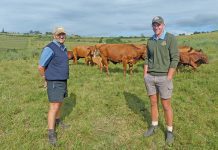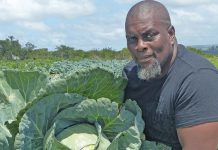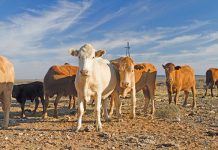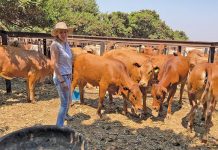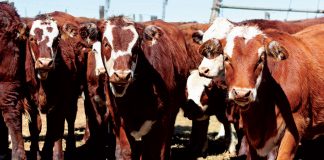
Photo: FW Archive
Subsistence livestock owners usually have no rules or customs for the improvement of their livestock through breeding. Most of these farmers allow their animals to breed more or less haphazardly and accept the results as inevitable, as they tend to place their confidence in herd numbers, rather than quality and reproduction performance.
Overstocking is a real challenge, as it further reduces production and increases veld degradation, fodder shortage, and poverty.
General problems include bulls that are too old, infertile animals or those with low fertility, and inbreeding.
The importance of the bull in a cattle-breeding programme is usually underestimated by subsistence farmers. A cow is responsible for half the genetic material in a calf, while the bull is responsible for half the genetic material in 25 or more calves. Keeping a defective bull can therefore be a costly business. Yet, sub-fertile bulls are common among subsistence farmers. The result is lower calving rates and a reduction in farm profits.
Subsistence farmers need to be provided with extension and training programmes
that will teach them the basics of animal husbandry, such as sustainable veld
management, breeding principles, and cow management. They also need to be advised on marketing skills, such as when, where and how to market their animals.
Sustainable beef production
Ideally, every developing farmer should want to improve the genetic composition and overall return on his or her beef cattle enterprise. Before this can happen, however, certain basics of farming management practices must be put in place. These include the following:
When introducing a bull to a new environment, allow it to adapt for at least three months before using it for breeding.
Make sure there are enough camps to keep cows and bulls separate, and so avoid unplanned mating. Maintain cows in good health, and implement the correct health programme for your area, such as vaccinating cattle for notifiable diseases at the right time.
Ensure that watering systems supply clean water throughout the production period, and keep the animals’ drinking troughs clean at all times. Maintain windmills and watering systems in good condition; repair leakages as soon as you notice them.
Apply appropriate stocking rates, and consult a veld expert for a recommendation on a grazing system suited to your area. Make every effort to keep grazing in a good condition.
Inspect your animals regularly to make sure they are in good breeding condition.
Ensure that selected bulls are fertile, virile, and injury-free.
Test all bulls for sexually transmitted diseases in advance of the mating season, and treat those animals that carry diseases. Ask a beef cattle specialist for advice if you’re not sure.
Buy a young, functionally sound bull that can provide support in an emergency. It must, however, be a bull earmarked for future use.
Purchasing beef cattle bulls
It’s always best to buy bulls from reputable breeders in your area. Such breeders should be registered with SA Stud Book or recognised beef-cattle associations, as this will guarantee accountability and reliability.
When selecting a bull, ask the following three questions:
- Is it fertile?
- Will it adapt well to your environment and production system?
- Will it produce calves of genetically superior quality?
When selling a bull on auction, a breeder would supply the buyer with records or provide information via the cattle catalogue. The bull certificate will tend to show performance records under extensive beef-cattle management conditions.
The fertility of the bull would have been tested by a veterinarian for semen quality and quantity, lack of reproductive disorders, and absence of venereal diseases. Many breeders’ associations provide records of the physical soundness of the bull, such as scrotal circumference, which also supports semen quantity. A large scrotal circumference indicates a higher degree of fertility.
Nonetheless, you as the buyer should personally evaluate the libido of the animal during mating season to ensure that it serves your cows regularly.
Hardiness
It is wise to choose a hardy bull that can adapt well to the veld. This means that you should buy a bull from a breeder who rears livestock under extensive veld conditions without introducing much additional feeding at certain periods of the year. However, a minimal amount of mineral supplements may be introduced in winter on farms with mostly sour vegetation types.
Overfed bulls usually need special maintenance, and therefore also require additional feeding programmes to sustain them.
Although choosing a bull may be influenced by your personal preference, it is recommended that you seek expert advice. It may take many years to correct an error made by buying one ‘wrong’ bull.
A bull that produces calves with heavy birthweights is a much bigger problem than a ‘mistake’ made by a single cow. An inferior bull can create problems in the offspring of all the cows it serves, whereas an inferior cow is responsible for poor traits in just one calf per year.
Sweetveld vs sourveld
Avoid buying a bull raised in sweetveld vegetation regions and moving it to sourveld vegetation in a high-rainfall area. Vegetation deteriorates in quality from the west to the east in South Africa, resulting in bulls often struggling to adapt to vegetation that is low in nutrition during winter months. This leads to low fertility and small calf crops.
Email Sechaba Majola at [email protected].

